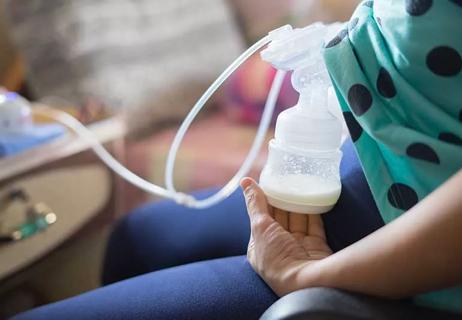When breastfeeding doesn’t go as planned, you may need to supplement with formula or donor breast milk — and that’s OK

You’ve heard that breastfeeding (chestfeeding) is the recommended way to feed your newborn, so you’ve been doing so since their birth. But it seems like your little one isn’t growing fast enough. And they won’t stop fussing — even after meals. How can you be sure they’re getting enough to eat? Is it time to give your baby formula or donor breast milk along with your own breast milk? And is that OK?
Advertisement
Cleveland Clinic is a non-profit academic medical center. Advertising on our site helps support our mission. We do not endorse non-Cleveland Clinic products or services. Policy
Most pediatricians agree naturally nutritious breast milk has a lot of benefits for you and your little one. Breastfeeding may help reduce your risk of getting postpartum depression or Type 2 diabetes. It may also help your baby avoid things like repeated ear infections or digestive problems.
Experts at the American Academy of Pediatrics (AAP) recommend breastfeeding for the first six months — until your baby tries solid foods. They then suggest breastfeeding and solid foods up to age 2.
But what if breastfeeding isn’t working for you or your baby, no matter how hard you try — or want to make it happen? You’re at a loss over what to do next.
It may be time to supplement breastfeeding with formula or donor breast milk. But are you letting your child down if you need to do this? The answer? Absolutely not.
“That’s a big misconception,” says pediatrician Heidi Szugye, DO. “Many breastfeeding challenges are out of our control.”
There are many reasons why you may need to supplement with formula. You might have also heard this called combo-feeding. And there are many different reasons why you may need to take this step or use formula instead of breast milk.
Problems with your milk supply can complicate breastfeeding. Your milk may not come in fast enough. Or your body might not make enough. These breastfeeding hurdles don’t affect your value as a parent. Not all parents have an instantaneous or abundant milk supply. Any breast milk your baby gets is great, but you may not be able to exclusively breastfeed. And that’s OK, Dr. Szugye reiterates.
Advertisement
“Your worth as a parent isn’t tied to the number of drops of breast milk you feed your baby,” she stresses. “Some parents are limited in how much milk they can produce. And some babies need temporary supplemental formula or donor breast milk for medical reasons. Many of these children go on to breastfeed exclusively.”
When you’re breastfeeding, look for signs your baby isn’t getting enough nutrition from breast milk alone. You may notice they:
Other newborn health conditions like hypoglycemia (low blood sugar) or jaundice are other reasons you may need to combo-feed your baby.
Your pediatrician may ask you to completely stop breastfeeding and feeding with pumped (expressed) milk. This may happen in a few rare circumstances.
Your little one may have a serious condition called galactosemia. This keeps them from processing a sugar called galactose. It’s in dairy products, breast milk and milk-based formulas. You’ll use soy-based or elemental formulas instead.
Pediatricians may also recommend formula feeding if you:
Sometimes, you may only need to stop breastfeeding temporarily. This can happen if you:
Before jumping into supplementing, you’ll want to talk with your pediatrician, lactation consultant or breastfeeding medicine providers. They can help you find the best breastfeeding and formula feeding schedule. And if you’re moving to feeding exclusively with formula, they can help you make that transition, too.
“You shouldn’t make this decision alone,” Dr. Szugye says. “If you’re struggling, I recommend talking with your medical providers. They can help you understand the reasons why you may need to supplement and if it is temporary or long term. We can go over all the options, so you feel you’ve made the best choice for you and your child.”
Your providers will help you learn how to supplement with formula. If you hope to go back to breastfeeding exclusively, you’ll want to keep pumping as much milk as you make. This can help keep your milk supply from drying up before you’re done supplementing.
Advertisement
If your baby can drink breast milk, and you have enough pumped milk for a bottle, try supplementing with that first. Use straight formula if you can’t express your milk or your child isn’t able to drink it.
This way of bottle feeding mimics breastfeeding. It allows your baby to lead feeding (responsive feeding) using a slower flow of pumped breast milk or formula. Look for cues from them, like rooting or sucking. Give them breaks and switch them between the sides of your lap like you would with breastfeeding. And allow them to stop feeding when they’re ready. It’s important not to force your baby to feed.
Cup feeding is exactly what it sounds like — feeding your baby breast milk or formula using a small cup. How? By sitting them upright on your lap and holding a small cup of milk to their mouth. Make sure the rim rests on their lower lip. Then, slowly tilt the cup so they can sip and swallow on their own.
Your provider may recommend one of two ways to use a tube or syringe for supplemental feeding:
Advertisement
Your healthcare providers will keep an eye on you and your baby while you supplement or formula feed. They’ll look for things like whether your baby is growing or gaining weight or if your milk supply has improved.
While you’re mixing breast milk and formula, you’ll want to watch your baby for signs of complications. It’s time to call the pediatrician if your baby:
Everyone’s parenting experience is different. Maybe exclusive breastfeeding is the approach that works for you. Or maybe combo-feeding or formula feeding is best in your situation.
Either way, remind yourself that you’re doing everything in your power to help your baby be healthy and happy. If you need to supplement with formula, you’re doing what your baby needs to help them grow and thrive in the best possible way. And that’s one of the most important decisions you can make.
Advertisement
Learn more about our editorial process.
Advertisement

Breastfeeding supplements can be a needless expense at best, and risky at worst

Typically, milk comes in a few days after birth and regulates around four weeks after delivery

From the football hold to the cradle hold, consider trying a variety of techniques

Gentle massaging, lying on your side and hand-expressing a little milk can help

Get your milk flowing by getting comfy, releasing stress and focusing on your baby

Popular myth says breastfeeding prevents pregnancy, but that’s not the whole story

With some exceptions, most are OK

Removing the piercing as early as possible is important for avoiding complications

Type 2 diabetes isn’t inevitable with these dietary changes

Applying a hot or cold compress can help with pain